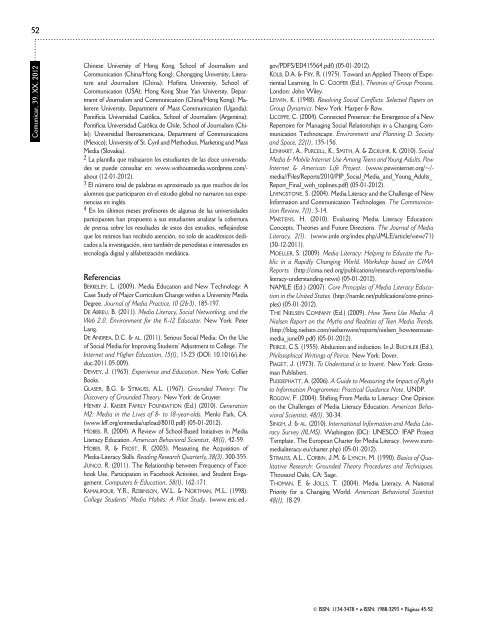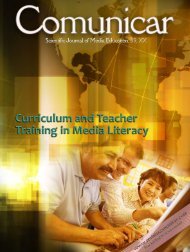Comunicar 39 - Revista Comunicar
Comunicar 39 - Revista Comunicar
Comunicar 39 - Revista Comunicar
Create successful ePaper yourself
Turn your PDF publications into a flip-book with our unique Google optimized e-Paper software.
52<br />
<strong>Comunicar</strong>, <strong>39</strong>, XX, 2012<br />
Chinese University of Hong Kong, School of Journalism and<br />
Communication (China/Hong Kong); Chongqing University, Litera -<br />
ture and Journalism (China); Hofstra University, School of<br />
Communication (USA); Hong Kong Shue Yan University, Depar -<br />
tment of Journalism and Communication (China/Hong Kong); Ma -<br />
kerere University, Department of Mass Communication (Uganda);<br />
Pontificia Universidad Católica, School of Journalism (Argentina);<br />
Pontificia Universidad Católica de Chile, School of Journalism (Chi -<br />
le); Universidad Iberoamericana, Department of Communi cations<br />
(Mexico); University of St. Cyril and Methodius, Marketing and Mass<br />
Media (Slovakia).<br />
2 La plantilla que trabajaron los estudiantes de las doce universidades<br />
se puede consultar en: www.withoutmedia.word press.com/ -<br />
about (12-01-2012).<br />
3 El número total de palabras es aproximado ya que muchos de los<br />
alumnos que participaron en el estudio global no narraron sus experiencias<br />
en inglés.<br />
4 En los últimos meses profesores de algunas de las universidades<br />
participantes han propuesto a sus estudiantes analizar la cobertura<br />
de prensa sobre los resultados de estos dos estudios, reflejándose<br />
que los mismos han recibido atención, no solo de académicos dedicados<br />
a la investigación, sino también de periodistas e interesados en<br />
tecnología digital y alfabetización mediática.<br />
Referencias<br />
BERKELEY, L. (2009). Media Education and New Technology: A<br />
Case Study of Major Curriculum Change within a University Media<br />
Degree. Journal of Media Practice, 10 (2&3), 185-197.<br />
DE ABREU, B. (2011). Media Literacy, Social Networking, and the<br />
Web 2.0. Environment for the K-12 Educator. New York: Peter<br />
Lang.<br />
DE ANDREA, D.C. & AL. (2011). Serious Social Media: On the Use<br />
of Social Media for Improving Students’ Adjustment to College. The<br />
Internet and Higher Education, 15(1), 15-23 (DOI: 10.1016/j.iheduc.2011.05.009).<br />
DEWEY, J. (1963). Experience and Education. New York: Collier<br />
Books.<br />
GLASER, B.G. & STRAUSS, A.L. (1967). Grounded Theory: The<br />
Discovery of Grounded Theory. New York: de Gruyter.<br />
HENRY J. KAISER FAMILY FOUNDATION (Ed.) (2010). Generation<br />
M2: Media in the Lives of 8- to 18-year-olds. Menlo Park, CA.<br />
(www. kff.org/entmedia/upload/8010.pdf) (05-01-2012).<br />
HOBBS, R. (2004). A Review of School-Based Initiatives in Media<br />
Literacy Education. American Behavioral Scientist, 48(1), 42-59.<br />
HOBBS, R. & FROST, R. (2003). Measuring the Acquisition of<br />
Media-Literacy Skills. Reading Research Quarterly, 38(3), 300-355.<br />
JUNCO, R. (2011). The Relationship between Frequency of Face -<br />
book Use, Participation in Facebook Activities, and Student Enga -<br />
gement. Computers & Education, 58(1), 162-171.<br />
KAMALIPOUR, Y.R., ROBINSON, W.L. & NORTMAN, M.L. (1998).<br />
College Students’ Media Habits: A Pilot Study. (www.eric.ed. -<br />
gov/ PDFS/ED415564.pdf) (05-01-2012).<br />
KOLB, D.A. & FRY, R. (1975). Toward an Applied Theory of Expe -<br />
riential Learning. In C. COOPER (Ed.), Theories of Group Process.<br />
London: John Wiley.<br />
LEWIN, K. (1948). Resolving Social Conflicts. Selected Papers on<br />
Group Dynamics. New York: Harper & Row.<br />
LICOPPE, C. (2004). Connected Presence: the Emergence of a New<br />
Repertoire for Managing Social Relationships in a Changing Com -<br />
munication Technoscape. Environment and Planning D. So ciety<br />
and Space, 22(1), 135-156.<br />
LENHART, A., PURCELL, K., SMITH, A. & ZICKUHR, K. (2010). Social<br />
Media & Mobile Internet Use Among Teens and Young Adults. Pew<br />
Internet & American Life Project. (www.pewinternet. org/~/ -<br />
media//Files/Reports/2010/PIP_Social_Media_and_Young_Adults_<br />
Report_Final_with_toplines.pdf) (05-01-2012).<br />
LIVINGSTONE, S. (2004). Media Literacy and the Challenge of New<br />
Information and Communication Technologies. The Communica -<br />
tion Review, 7(1), 3-14.<br />
MARTENS, H. (2010). Evaluating Media Literacy Education:<br />
Concepts, Theories and Future Directions. The Journal of Media<br />
Literacy, 2(1). (www.jmle.org/index.php/JMLE/article/view/71)<br />
(30-12-2011).<br />
MOELLER, S. (2009). Media Literacy: Helping to Educate the Pu -<br />
blic in a Rapidly Changing World. Workshop based on CIMA<br />
Reports. (http://cima.ned.org/publications/research-reports/medialite<br />
racy-understanding-news) (05-01-2012).<br />
NAMLE (Ed.) (2007). Core Principles of Media Literacy Educa -<br />
tion in the United States. (http://namle.net/publications/core-principles)<br />
(05-01-2012).<br />
THE NIELSEN COMPANY (Ed.) (2009). How Teens Use Media: A<br />
Nielsen Report on the Myths and Realities of Teen Media Trends.<br />
(http://blog.nielsen.com/nielsenwire/reports/nielsen_howteensusemedia_june09.pdf)<br />
(05-01-2012).<br />
PEIRCE, C.S. (1955). Abduction and induction. In J. BUCHLER (Ed.),<br />
Philosophical Writings of Peirce. New York: Dover.<br />
PIAGET, J. (1973). To Understand is to Invent. New York: Gross -<br />
man Publishers.<br />
PUDDEPHATT, A. (2006). A Guide to Measuring the Impact of Right<br />
to Information Programmes: Practical Guidance Note. UNDP.<br />
ROGOW, F. (2004). Shifting From Media to Literacy: One Opinion<br />
on the Challenges of Media Literacy Education. American Beha -<br />
vioral Scientist, 48(1), 30-34.<br />
SINGH, J. & AL. (2010). International Information and Media Lite -<br />
racy Survey (IILMS). Washington (DC): UNESCO: IFAP Project<br />
Template. The European Charter for Media Literacy. (www.euromedialiteracy.eu/charter.php)<br />
(05-01-2012).<br />
STRAUSS, A.L., CORBIN, J.M. & LYNCH, M. (1990). Basics of Qua -<br />
li tative Research: Grounded Theory Procedures and Techni ques.<br />
Thousand Oaks, CA: Sage.<br />
THOMAN, E. & JOLLS, T. (2004). Media Literacy. A National<br />
Priority for a Changing World. American Behavioral Scientist<br />
48(1), 18-29.<br />
© ISSN: 1134-3478 • e-ISSN: 1988-3293 • Páginas 45-52

















